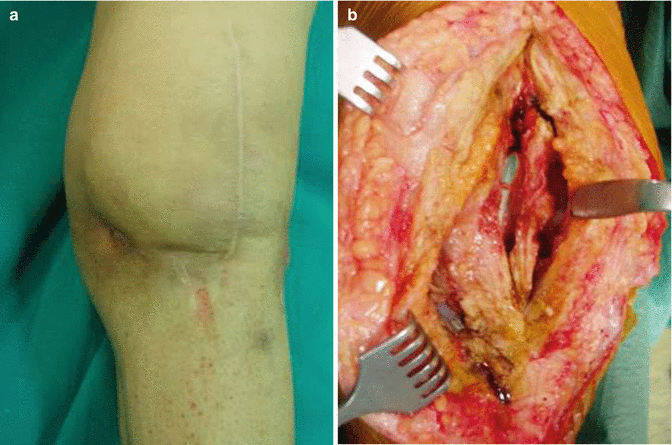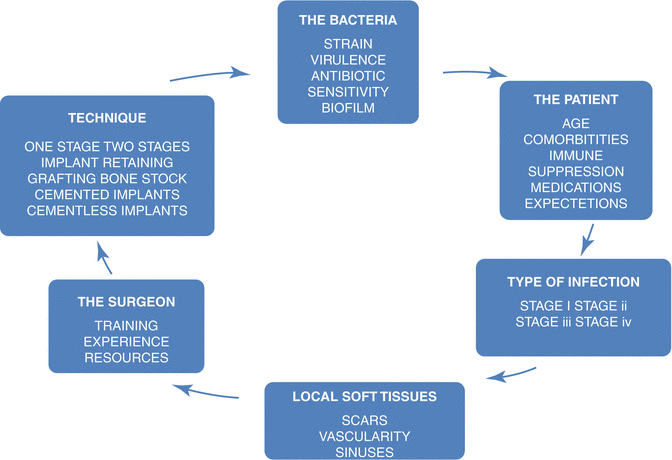Fig. 22.1
Intraoperative view showing an infected TKA with biofilm formation
There are well recognized risk factors which increase the risk for TKA infection such as rheumatoid arthritis, hemophilia, diabetes, obesity, hypertension, steroid therapy, poor general health, history of previous surgical procedures and wound related complications [9, 10]. Risk factors for perioperative SSI include male gender, liver disease, cancer, electrolyte disorders, congestive heart failure and pulmonary circulatory disease [5, 11]. As far as the pathogen is concerned, periprosthetic infections with MRSA are associated with higher rates of re-infection [12]. Approximately 72 % of pathogens seem to be Gram positive, 7 % Gram negative and 0,6 % fungal, while in around 21 % of the cases no organism has been identified.
Diagnosis of an infected knee remains a challenge for orthopaedic surgeons. Swelling, tenderness and pain in an operated knee raises the suspicion for infection. Diagnosis depends on the clinical picture, plain radiographs, bone scans, serologic tests, routine blood work (ESR, CRP, interleukin-6 and glucose levels), knee aspiration and synovial fluid examination, intraoperative cultures and histology [3, 13–18]. Molecular diagnostic tests are now available for clinical use. Classification systems have been developed in order to aid the management of decision making. These systems were initially based on the time of appearance and duration of symptoms and signs (stage I – infections occurring within 6 weeks of implantation, stage II – infections being delayed chronic presentations, stage III – late infections occurring in a previously well-functioning joint and stage IV – an unexpected positive culture result in aseptic revision surgery) but it later became apparent that factors such as pathogen, patient (comorbidities, immunosuppression, medication) and the quality of local tissue are also important and determine outcome [19] (Fig. 22.2). Extensor mechanism and knee soft tissue envelope problems require a low threshold for early plastic surgery intervention.


Fig. 22.2
(a) Preoperative appearance of compromised knee soft tissue envelop, (b) following wide infected tissue debridement extensor mechanism defects are found
Due to the heterogeneous nature of the disease, surgeons face several management challenges related to the numerous species of bacteria with variable antibiotic sensitivity, to abnormal bone and soft tissue environments, patients with comorbidities etc. (Fig. 22.3). Theoretically optimal treatment management is difficult to apply to all patients, and high quality comparative clinical data is lacking. Moreover, published data focus on control of infection (with a variable infection free time period), providing limited information about functional recovery, mechanical complications and aseptic loosening. Recently, an attempt has been made to draw diagnostic and treatment guidelines (consensus agreement) [20]. There is growing evidence that we are now dealing with a “different enemy”. Staphylococcus aureus (MRSA), enterococcus (VRE), gram negatives (pseudomonas) or polymicrobial infections are all exhibiting more aggressive biological behavior. In the past a low percentage of pathogens were developing biofilm approximately 3 weeks after surgery [21, 22]. Now 80–90 % of the pathogens develop biofilm as early as 1–10 days [21, 22]. We therefore believe that the acute infection stage, published management strategies and literature data including interpretation of old series should be reconsidered.


Fig. 22.3
Infected total knee arthroplasty management strategies. Factors influencing mid and long term outcome
Management Strategies
Treatment options vary. Prevention remains the key for the overall control of infection. Therapy depends on many factors such as the chronicity of the infection, stability of the components, medical status of the patient and is determined by surgeon experience and facilities [10, 17] (Fig. 22.3). Sometimes an infectious disease consultant is also involved in the treatment care plan and advises about the best antibiotic and home care [18]. There are simple procedures like irrigation, implant retention after debridement and polyethylene exchange, and antibiotic suppression, or complex ones like one stage exchange technique, two stage exchange technique, arthrodesis, resection arthroplasty and amputation. The gold standard for infection control is still the two stage revision procedure [13, 15, 16, 23].
Debridement and retention of the implants is not widely accepted. It is the least invasive method; however, it requires careful patient selection. Debridement with component retention can be used with varying degrees of success (approximately 80 % clinical efficacy), especially in the acute postoperative period with only one attempt permitted [10, 24]. It is usually used in healthy patients with acute onset of symptoms and it results in better knee function [13] (Fig. 22.4). Arthroscopic debridement and retention of implants may also be used in acutely infected TKAs. This method is not widely used and therefore little is known about its role and success rate in the management of joint infection. Published data show 62.5 % success rate in a small sample of 16 acute infections followed up for 2 years [25].


Fig. 22.4
Implant salvage in a TKA with early postoperative infection. (a) Wide infected tissue debridement, (b) temporary implantation of antibiotic loaded beads
The one stage exchange procedure is well established for infected THA with long term results at the level of 10 years. However, it is not widely supported and approved in the literature. Nevertheless, it seems that single stage revision has its role in the management of TKA infections and its use is gaining popularity. It can be used in certain patients where the causative pathogen is known, no sinuses are present, the patient is not immunocompromised and there is no radiological evidence of component loosening or osteitis [4]. It has some advantages like less surgical procedures and therefore lower costs and lower hospitalization. One stage might provide better knee function but infection control remains unclear [26]. Goksan and Freeman published their results in 1992 with a success rate of 90.9 % at an average of 10 years [27]. Similar results were published in 2004 by Buechel et al. [28] who treated 22 infected knees with one stage exchange revision arthroplasty. Their results showed an infection free rate of 90 % with knee scores of 79,5 on average at 10 years follow up. In 47 patients treated with one stage exchange, 41 (87 %) were infection free at 3 years follow-up [26]. However, knee function was not improved when compared to that of historical control patients having two stage exchange. Parkinson et al. [11] presented “two in one technique” in 2008. It is similar to the two stage technique except that the time interval between the two procedures is minutes instead of 4–6 weeks, but this technique has an unconfirmed clinical outcome. There are studies showing that one stage exchange is not associated with higher rates of infection recurrence and failure (Table 22.1). They show survival rates of 87 % on average at the level of 3 years follow up. Many authors believe that one stage revision produces reproducible high quality results and will soon achieve the same widespread acceptance in the knee as it does in infected hip arthroplasty. However, despite the low infection relapse rates published, the high failure rate of 27 % reported by Von Foerster et al. [29] in a large series of 118 infected knees suggest that further research is needed.
Table 22.1
Clinical outcome studies with one stage exchange procedure
Study | Strategy | Number of patients | Mean follow up | Infection free survival rate (%) | Mean knee society function score (points) |
|---|---|---|---|---|---|
Bauer et al. [30] | 1 stage | 30 | 52 months | 67 | 62.5 |
Buechel et al. [28] | 1 stage | 22 | 10.2 years | 90.9 | |
Göksan and Freeman [27] | 1 stage | 19 | 4.6 years | 89 | |
Lu et al. [31] | 1 stage | 8 | 20 months | 100 | |
Scott et al. [32] | 1 stage | 10 | 70 | ||
VonFoerster et al. [29] | 1 stage | 104 | 5–15 years | 73 |
Two stage revision remains the gold standard for the management of infected TKA [3, 10, 11, 14, 24, 36, 37, 39]. It is reported to have higher infection free rates (Table 22.2). The method was first presented by Insall et al. in 1983 [39]. It involves prosthesis removal followed by delayed reimplantation. There is an interval of 4–6 weeks between the two procedures during which the patient is given antibiotic therapy. Tissue cultures taken during the first surgery can identify the infecting pathogen and define antibiotic treatment. When infection persists despite antibiotic therapy, the first stage of the procedure is repeated [40, 61]. Articulating or static spacers are used. Systematic infection, presence of sinus track, compromised soft tissues and unknown or antibiotic-resistant pathogens are also indications for the two stage procedure. A relative contraindication is acute infection caused by a known pathogen that can be managed with synovectomy and antibiotic therapy or the one stage procedure [41]. Disadvantages, compared to one stage procedure, are impaired mobility, joint stiffness and pain, higher cost of treatment and longer hospital stay [11]. Goldman et al. [42] found an infection free rate of 91 % at 10 years in a survey of 64 two stage procedures without the use of antibiotic loaded cement. A review of 253 two stage revision procedures in 2012 showed an overall infection free survival rate of 85 % at 5 years and 78 % at 10 years [38]. Haleem et al. [43] published a 77 % survival rate at 10 years for revision for any reason as an end point in a series of 96 two stage revision TKAs. Bauer et al. [30] published a multicenter retrospective study comparing one and two stage revisions for infection and found no difference between the two techniques in eradicating infection. As far as functional knee outcome is concerned, the one stage procedure showed better outcome. In a study from the Netherlands, which included 15 patients with mean follow up of 25 months, an attempt was made to compare the two stage procedure to debridement without implant removal. The infection free rate of the staged procedure was 100 % and only 37 % with the salvage procedure at a minimum 5 years follow up [44]. In another study with 20 infected TKAs, who were treated with the two stage procedure, no need for revision was recorded at an average of 6 years follow up [41]. In a recent systematic review with a large number of incidents (204 knees with one stage procedure and 1,421 with two stage) the infection free survival rate was 89.8 % for the two stage and 81.9 % for the one stage procedure at a mean follow up of 44 months [45]. Two stage reimplantation is still effective for treating contemporary pathogens, many of which are multi-antibiotic resistant (MAR). In a series of 75 infected TKAs, the infection free rates were similar to both MAR (91.2 %) and non MAR (91.3 %) infections at 2 years follow up [35].
Table 22.2
Clinical outcome studies with two stage exchange procedure
Study | Year published | Number of infection free patients (%) | Mean follow up (months) |
|---|---|---|---|
Insall et al. [49] | 1983 | 10/11 (91) | 34 |
Wilde and Ruth [50] | 1988 | 9/10 (90) | 33 |
Booth and Lotke [51] | 1989 | 24/25 (96) | 25 |
Teeny et al. [52] | 1990 | 10/10 (100) | 42.5 |
Wilson et al. [53] | 1990 | 16/20 (80) | 34 |
Masri et al. [54] | 1994 | 22/24 (92) | 26 |
Goldman et al. [42] | 1996 | 58/64 (91) | 90 |
Hirakawa et al. [55] | 1998 | 41/55 (75) | 62 |
Fehring et al. [56] | 2000 | 51/55 (93) | 36 |
Durbhakula et al. [57] | 2004 | 22/24 (92) | 33 |
Haleem et al. [43] | 2004 | 87/96 (91) | 86 |
Cuckler [33] | 2005
Stay updated, free articles. Join our Telegram channel
Full access? Get Clinical Tree
 Get Clinical Tree app for offline access
Get Clinical Tree app for offline access

|




